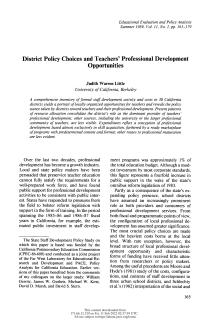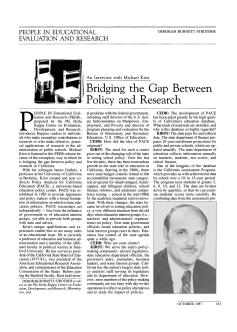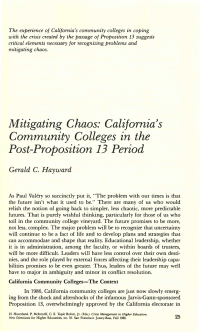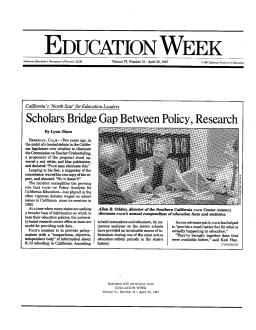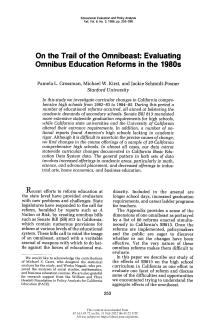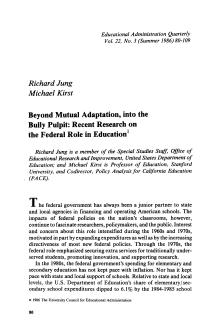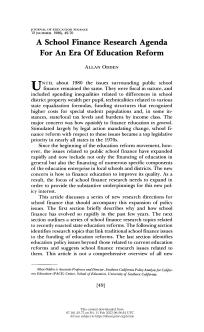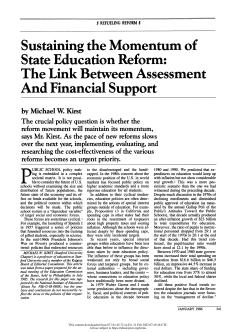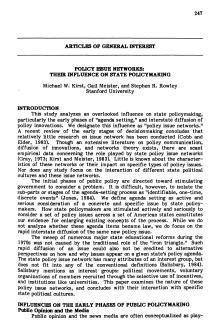Issues and Options for Early Childhood Programs
Published
Summary
The growing demand for compensatory education and for child care has generated a rash of federal legislation; many states have enacted new early childhood programs, most of them located within schooling systems, and many others are considering their options. This article examines the basic policy issues governments confront in early childhood education, including the content of programs, their financing, and the inevitable trade-off between cost and quality. The final section of the article outlines the available policy options.
Published
Summary
An inventory of 30 California districts reveals their policy stance on teacher professional development, which primarily consists of skill acquisition through district-led programs. Other sources, such as universities or professional communities, are less visible. The districts are the dominant providers of development opportunities, with expenditures reflecting a ready marketplace of predetermined programs. Alternative routes to professional growth are less evident.
An Exploration of the Debate on School District Size
Published
Summary
The notion that larger school districts are superior has changed, with some researchers advocating for smaller ones. Recent reform reports have focused on the school site as the decision-making seat. Three main issues guide district size research: fiscal efficiency, school effectiveness, and community identity. Although research has been conducted, there is still no definitive answer. This article explores the research and debate on the "right" size for school districts and identifies unanswered questions, hoping to kindle interest in further research.
Looking Backward and Forward
Published
Summary
1983 marked the beginning of state education reform with the release of the Nation at Risk report. Although many states had already passed education legislation, the last states joined in 1987. The reform's diffusion and breadth is impressive, and its consistency in concept makes it a hallmark in state policymaking. With initial statutes based on the 1983 concepts completed, the question remains whether a second wave will occur or if momentum has been spent.
Published
Summary
This article examines whether state-level initiatives for school reform can improve local schools. California's comprehensive reform legislation, SB 813, aimed to alter curriculum and instruction in almost every school in the state. The effects of such a broad range of reforms on local districts and schools are not well understood. While earlier studies indicate that the reforms were being implemented, questions remain about how they operate in local schools and whether they result in substantive change. The answers to these questions are crucial for policymakers and practitioners alike.
Bridging the Gap Between Policy and Research
Published
Summary
Michael Kirst, professor at Stanford University and former president of the California State Board of Education, is interviewed by People in Education Evaluation and Research (PEER). Kirst co-directs the Policy Analysis for California Education (PACE) project, an independent education policy center that provides unbiased research to legislators and policy makers. With Kirst's extensive experience in education and government, he is uniquely qualified to understand multiple sides of educational issues.
California's Community Colleges in the Post-Proposition 13 Period
Published
Summary
The passage of Proposition 13 in 1978 sent shockwaves through California's community colleges, affecting all aspects of their operations. The crisis exposed the colleges' lack of preparedness for such magnitude, leaving them grappling to cope with chaos. This article looks at California's experience and highlights critical elements necessary for recognizing problems and mitigating chaos. Educational leadership will need to be adept at ambiguity and conflict resolution as the future promises to be more complex and unpredictable. Finance, mission, and governance are the three key areas of focus.
Published
Summary
PACE, a university-based research center, provides "nonpartisan, objective, independent" information on K-12 schooling in CA. Its analyses have been invaluable to lawmakers and educators during the state's active education-reform period. PACE has played a growing role in debates on school issues, exemplified by a heated debate in the CA legislature over the Commission on Teacher Credentialing. PACE offers a model for providing data for education policies when many states are seeking broader information bases. It has helped provide a better understanding of what is happening in education.
The Next Needed Education Reform
Published
Summary
Educational reform in the US has shifted from equal opportunities to greater school productivity. There are some positive results with increased enrolment in academic courses, rigorous textbooks, and raised admission standards for higher education. However, fundamental components of the reform are at odds with the dynamics of organizational revitalization. Without policies that unleash productive local initiatives, the reform is likely to lose momentum, eroding citizens' confidence in schools and generating public resources for them.
Evaluating Omnibus Education Reforms in the 1980s
Published
Summary
The study examines curricular changes in California's high schools from 1982 to 1985, a period of educational reforms aimed at increasing academic rigor. The state mandated more extensive graduation requirements while universities adjusted their entrance requirements. A sample of 20 comprehensive high schools shows increased academic offerings in math, science, and advanced placement, and decreased offerings in industrial arts, home economics, and business education, reflect statewide trends.
Recent Research on the Federal Role in Education
Published
Summary
This article reviews the literature on federal involvement in U.S. elementary and secondary education, from the 1960s to the present day. The federal government's share of spending has decreased since the 1980s, and regulatory pressures have subsided. However, this review identifies trends and themes that have emerged in the literature since the 1980s, encompassing both empirical research and normative commentaries. A literature review primarily focuses on work completed after the early 1980s research syntheses and excludes judicial policies.
Published
Summary
Before the 1970s, public school finance issues were mainly related to spending inequalities. However, since then, the focus has shifted towards financing education to improve its quality. This article suggests new research directions for school finance that address this policy interest, including topics related to state education reforms, traditional school finance issues, and education policy issues beyond current reforms.
The Link Between Assessment and Financial Support
Published
Summary
Public school policy making is embedded in a complex societal matrix. It is not possible to consider the future of U.S. schools without examining the size and distribution of future populations; the future state of the economy and its effect on funds available for the schools; and the political context within which decisions will be made. The public school system is a "dependent variable" of larger social and economic forces.
Published
Summary
Several state legislatures have acted on recommendations to improve U.S. public schools, resulting in a swift and broad education reform movement. States have expanded school improvement programs, increased high school graduation and college admission requirements, deepened course offerings, and strengthened the teaching profession. Indicators of progress include longer school attendance, tougher academic courses, better counseling, higher achievement test scores, and increased teacher pay. This swift and broad movement gives reason for optimism about its success.
Their Influence on State Policy Making
Published
Summary
This report analyzes the role of policy issue networks in early state policymaking stages and interstate diffusion of policy innovations. It defines agenda setting as active and serious consideration of a specific issue by state policymakers and investigates how state policymakers are stimulated to consider policy issues across the U.S. The authors further examine the nature of policy issue networks and their interaction with specific state political cultures, providing insights into the rapid interstate diffusion of new policy issues in the 1970s.

